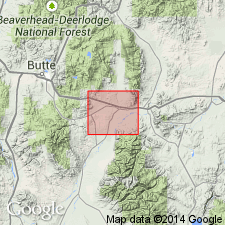
- Usage in publication:
-
- Renova Formation
- Modifications:
-
- Principal reference
- Dominant lithology:
-
- Limestone
- Mudstone
- Siltstone
- Sandstone
- Conglomerate
- AAPG geologic province:
-
- Montana folded belt
Summary:
Named as lower of 2 formations of Bozeman Group (revised). Type section located 1.25 mi southeast of Renova, for which unit is named, along east side of Jefferson River; base is in NW NW sec 33, T1N, R4W, and top is in SW NW sec 28, T1N, R4W, Madison Co, MT, Montana folded belt province. Principal reference sections (3): Pipestone Springs, NW NW sec 29, T2N, R5W and East Lily, S1/2 sec 16, T2N, R5W, Jefferson Co; Lower Parrot Bench, secs 23, 26, 27, T1N, R4W, Madison Co. Outcrops over 15 sq mi in Jefferson basin (north of Tobacco Root Mountains, south of Bull Mountain, and along western margin of basin). Divided into Bone Basin (new) and Climbing Arrow (rank reduced) Members (about equivalent ages) at base and Dunbar Creek Member (rank reduced) at top. Name Renova introduced because rocks that comprise it have a natural lithologic and stratigraphic unity best expressed as a single formation-rank unit (rather than equivalent Climbing Arrow and Dunbar Creek Formations as used in Three Forks basin). At type, Renova is 965 ft thick (top not exposed); consists of alternating micrite, montmorillonite, mudstone, vitric siltstone, vitric arenite, arkose, and minor conglomerate and opal. Thickness up to 3,500+ ft. Unconformably overlies pre-Tertiary rocks; unconformably underlies Sixmile Creek Formation of Bozeman Group. Geologic map, correlation chart, fossil list, cross sections. Oligocene age based on fossil vertebrates.
Source: GNU records (USGS DDS-6; Denver GNULEX).
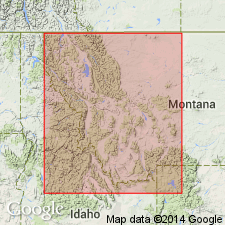
- Usage in publication:
-
- Renova Formation
- Modifications:
-
- Age modified
- AAPG geologic province:
-
- Montana folded belt
Summary:
Greatest age range within study area is in upper Ruby River basin, Montana folded belt province. Here age ranges from late Uintan or Duchesnean (late Eocene) to late Arikareean (early Miocene) [see addendum, p. 36 and Appendix A]. Ages based on mammalian fossils.
Source: GNU records (USGS DDS-6; Denver GNULEX).
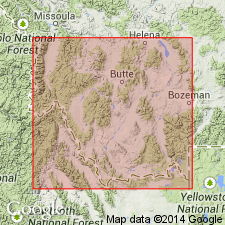
- Usage in publication:
-
- Renova Formation*
- Modifications:
-
- Not used
Summary:
Historical use of formal stratigraphic nomenclature applied to Bozeman Group in southwest MT, Montana folded belt province described. Charts. Bozeman and its formations --Sphinx Conglomerate (oldest), Milligan Creek, Climbing Arrow, Dunbar Creek, Sixmile Creek of the Toston-Clarkson Valley areas, and the Renova (oldest) and Sixmile Creek Formations of the Jefferson-Beaverhead Valley areas not used. These Tertiary rocks considered to be basin-fill deposits separable on basis of sequence stratigraphic concepts, rather than on lithostratigraphic principles. Lithologic distinctions within the group are not distinctive due to abrupt lateral facies changes. These rocks are separable into 5 sequences, numbered 1 to 5, no. 1 is the oldest, no. 5 is post-Bozeman alluvium. Each sequence is separated by an unconformity. Term unconformity applied in this paper to surfaces of non-deposition or erosion, these surfaces have soils developed on them. Sequence 1 consists of calc-alkalic flows, flow tuffs, tuff, matrix-supported conglomerate, some massive sandstone about 157 m thick, and is of Eocene age. Sequence 2 is mostly fluvial channel conglomerate, sandstone, mudstone, siltstone, and minor tuff, lapilli tuff about 400 m thick, and is of Eocene and Oligocene age. Sequence 3 is fluvial sheet sandstone, some mudstone, siltstone, sandstone, lenses of conglomerate of flood plain origin about 214 m thick, and is of Oligocene and Miocene age. Sequence 4 is mudstone, siltstone, sandstone, lenses of conglomerate mostly of flood plain origin 1,000 m thick, and is of Miocene and Pliocene age. Sequence 5 unconformably overlies rocks that were assigned to the Bozeman. Map shows distribution of the 5 sequences. The unconformities can be traced into the subsurface seismically.
Source: GNU records (USGS DDS-6; Denver GNULEX).
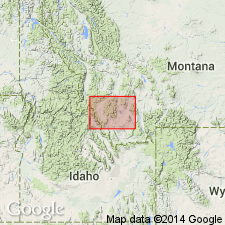
- Usage in publication:
-
- Renova Formation
- Modifications:
-
- Not used
Summary:
Bozeman Group of Eocene to Pliocene age is mapped as an undivided unit with some unnamed Tertiary valley-fill deposits. Although Bozeman has been divided into the Sixmile Creek and Renova Formations mainly on the basis of mammalian fauna, these formation names are not used in the Dillon quad because they cannot be separated lithologically at most localities in this quad. Mapped on both sides of Jefferson and Ruby Rivers in the eastern part of the quad, in the south-central and southwest and west-central parts of the map area, Madison and Beaverhead Cos, MT in the Montana folded belt province. Map unit is more than 4000 m thick.
Source: GNU records (USGS DDS-6; Denver GNULEX).
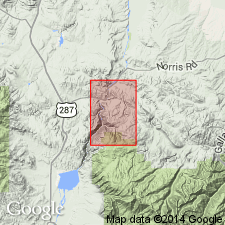
- Usage in publication:
-
- Renova Formation*
- Modifications:
-
- Mapped 1:24k (Bear Trap Creek quad, Madison Co, MT)
- Dominant lithology:
-
- Siltstone
- Sandstone
- Conglomerate
- AAPG geologic province:
-
- Montana folded belt
Summary:
Here consists only of Dunbar Creek Member which is mapped in east-central part of quad, Madison Co, MT, Montana folded belt province (following Kuenzi and Fields, 1971). Dunbar Creek is white, yellowish-white, and light-gray, moderately indurated to well indurated siltstone, sandstone, and matrix-supported conglomerate; most beds are tuffaceous and some sandstones are composed entirely of water-lain ash. Contains twig debris in some ash beds and bone fragments in some pebbly beds. Thickness is greater than 120 m. Conformably overlies Milligan Creek Formation; underlies Tertiary diamicton. Oligocene age.
Source: GNU records (USGS DDS-6; Denver GNULEX).
For more information, please contact Nancy Stamm, Geologic Names Committee Secretary.
Asterisk (*) indicates published by U.S. Geological Survey authors.
"No current usage" (†) implies that a name has been abandoned or has fallen into disuse. Former usage and, if known, replacement name given in parentheses ( ).
Slash (/) indicates name conflicts with nomenclatural guidelines (CSN, 1933; ACSN, 1961, 1970; NACSN, 1983, 2005, 2021). May be explained within brackets ([ ]).

